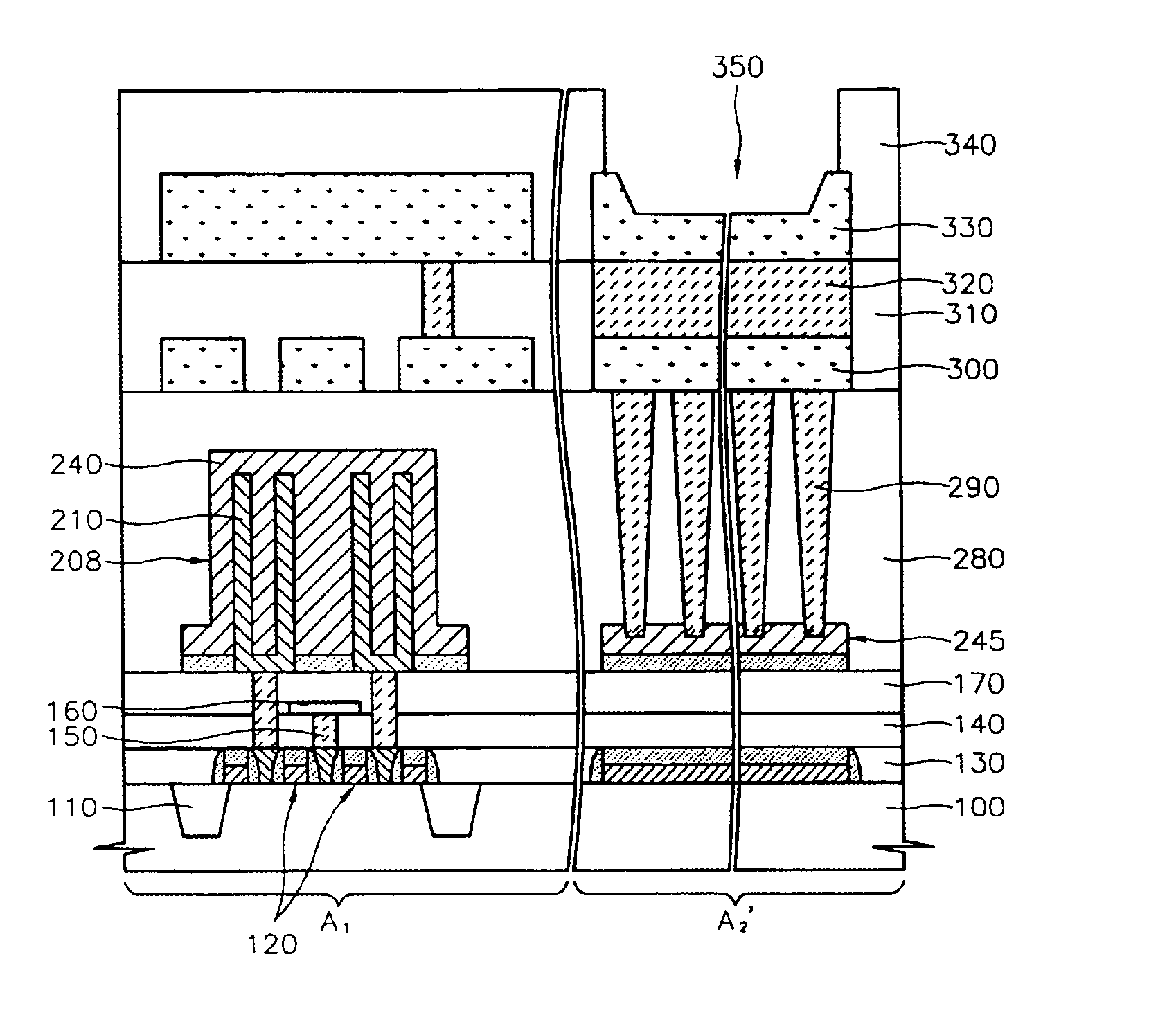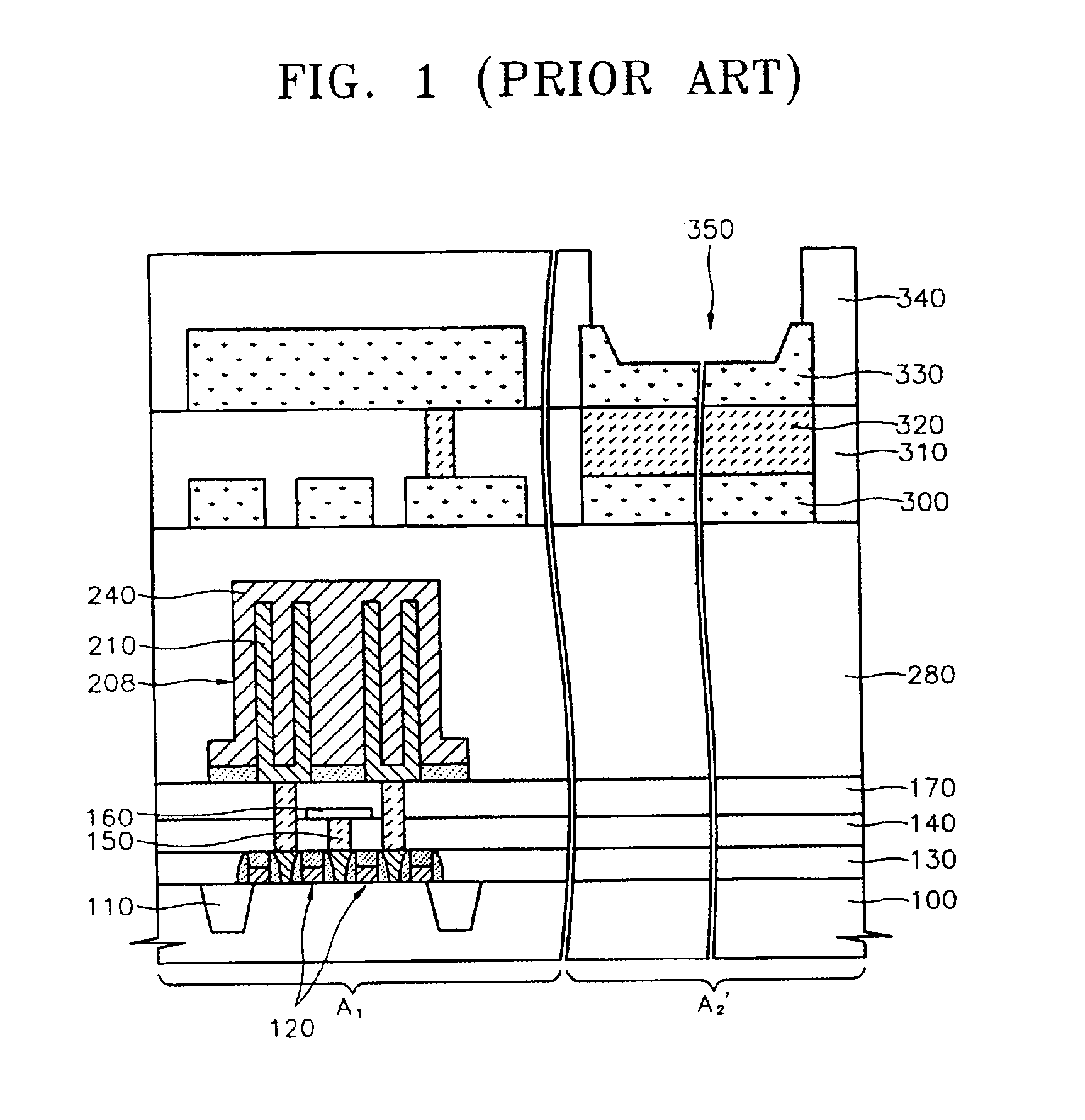Bonding pad structure of a semiconductor device and method for manufacturing the same
a technology of bonding pad and semiconductor device, which is applied in the direction of semiconductor device, semiconductor/solid-state device details, electrical equipment, etc., can solve the problems of many additional fabrication process steps for implementation, and achieve the effect of minimizing or eliminating additional or special process steps and improving the resistance to layer delamination
- Summary
- Abstract
- Description
- Claims
- Application Information
AI Technical Summary
Benefits of technology
Problems solved by technology
Method used
Image
Examples
first embodiment
FIG. 2 illustrates a bonding pad structure according to the present invention. An IC memory cell A1 comprising a capacitor 208 having electrodes 210 and 240 may be included in a first, a second, a third, and a fourth dielectric layers, 130, 140, 170, and 280, respectively.
The bonding pad structure is created beneath and connected to a bonding pad 350 simultaneously with the processing of the capacitor 208 of memory cell A1. Anchoring elements of the bonding pad structure preferably comprises a dummy pattern 245 being formed on the third interlayer dielectric 170, which is conductively and mechanically connected by a plurality of plugs 290 through interlayer dielectric 280 to a lower portion of a multi-layered bonding pad 350, and more specifically, to a first aluminum interconnection layer 300.
In order to connect first aluminum interconnection layer 300 to the dummy pattern 245, contact holes are formed in interlayer dielectric 280 in a bonding pad region A2′ to the depth of dummy p...
second embodiment
as shown in the processing of bonding pad region A2″ in FIGS. 4-1 through 4-18, smaller depth of a bonding pad contact hole allows for easier and more uniform formation of both the bonding pad contact holes and the tungsten filler plugs 295. As was shown in the preceding steps for bonding pad region A2′, the dummy patterns under the bonding pads may be easily formed at the same time and during the same process steps that were used for the construction of the capacitor, i.e. without the need of extra process steps, or at most a minimum number of additional steps.
FIG. 5 illustrates a bonding pad structure according to a third embodiment of the present invention. In the embodiment illustrated in FIG. 5, a trench is not formed in the second interlayer dielectric 140, unlike in the second embodiment. In this embodiment, a capacitor pattern may be constructed beneath the bonding pad 350 for use as a dummy pattern, rather than the dummy pattern in trench 155 of FIGS. 4-3, thereby eliminati...
fourth embodiment
FIG. 6 illustrates a bonding pad structure according to the present invention. In this embodiment, a tungsten plug 355 (or plugs) may have a rectangular-shaped, wedge-shape, or even solid cubic-shaped characteristics. The selection of a particular shape and or depth of a plug 355 is related to a design selection regarding the materials and complexity of the construction vs. the advantages obtained. Such advantages may relate to the reliability of the structure or some other electronic or mechanical performance parameter, such as current-carrying capability or mechanical flexibility.
PUM
 Login to View More
Login to View More Abstract
Description
Claims
Application Information
 Login to View More
Login to View More - R&D Engineer
- R&D Manager
- IP Professional
- Industry Leading Data Capabilities
- Powerful AI technology
- Patent DNA Extraction
Browse by: Latest US Patents, China's latest patents, Technical Efficacy Thesaurus, Application Domain, Technology Topic, Popular Technical Reports.
© 2024 PatSnap. All rights reserved.Legal|Privacy policy|Modern Slavery Act Transparency Statement|Sitemap|About US| Contact US: help@patsnap.com










